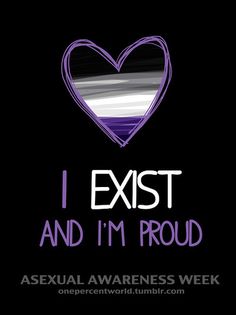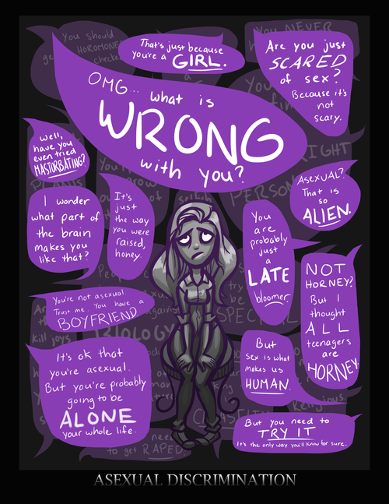Sexual Erasure in Media

Sexuality is a very significant part of our society. In some people, being able to identify themselves with a sexuality helps them feel like they are not all that different or alone in the world. However, erasure works as a means of erasing the representation of non hetero-conforming sexual identities. Not all forms of erasure occur from outside the LGBTIQA movement. Bisexual, asexual and pansexual people struggle with the threat erasure posses from within sexual rights groups. (14) Asexual people make up a very small portion of the population and because of this, representation and general understanding for the sexuality is still relatively low. Asexual people experience staggering amounts of erasure and silencing, even within LGBT communities and groups. Many LGBT circles do not incorporate asexuality, stating that asexual is a lack of sexuality and therefore not technically a sexuality, or that asexual people do not experience discrimination. Despite this, asexual people do struggle with acceptance and discrimination within their homes and community.
There has been dispute to have the A in GLAAD, a group associated with LGBT+ rights, which as of now stands for Ally only, to be changed to stand for Asexual, Aromantic, Agender and Ally (AVEN). It is not that asexual people want to take away the respect for those supporting these sexualities as an ally, asexual people just want representation for their sexuality as well. There was a time when the T for "transexual was not included under the LGB umbrella; similar arguments were used to reject the trans community from the acronym" as well. (4) There is no denying that asexual people experience less openly hostile phobia towards their sexuality than other allosexual identities; however, asexual individuals experience much less visibility and greater erasure from society. Within media, very few TV shows, movies, or literature depict characters who are uninterested in people sexually, and even in cases where this is true, these characters are seen as being uninterested in sex entirely. Even within famous sex research, such as Kinsey's in the 1940's, asexuality has been altogether glossed over. Low awareness and representation for this sexual orientation has lead to many misconceptions and problems.
Misconceptions and Lack of Public Understanding

Many people find it difficult to see asexuality as an identity. For those people, it is hard to understand how asexual individuals have no sexual feelings of attraction to either the gender and/or sex of a person. Because of this, even under well intended efforts to understand, misconceptions and hurtful notions can arise. First off, asexuality is not due to a history of mental illness or sexual abuse. Asexual people are just born without sexual attraction. In the medical community many people assume that assexuals can be diagnosed with "Hypoactive Sexual Desire Disorder (HSDD)", characterised by sexual dissatisfaction and treated with couples therapy. Asexuality is a sexual orientation, not a disorder. (2) Asexuality stems from not feeling sexual attraction to begin with, not sexual dissatisfaction. As with many other non-heteronormative sexualities in the past, it can not be treated with therapy. Second, being asexual is not due to "not discovering the right person yet." Like any other sexuality it is about who a person is or is not attracted to to begin with. (4)
Due to the fact that sexuality is fluid, a person may later stop describing themselves as asexual; however, that does not mean that the person was not asexual before. Finally, asexual people do not abstain due to some sense of moral superiority, it is simply because they do not feel sexual attraction. (Note: this does not mean asexuals can't feel romantic attraction or find sex pleasurable) (See Asexuality and Sex under the Asexuality link).
Negative Impact of Heteronormativity & Patriarchial Ideologies on Asexual Idenity
Heteronormativity is "the view that institutionalized heterosexuality constitutes the standard for legitimate and expected social and sexual relations." (13) Due to this, our entire culture has been shaped to believe that marriage between a man and a woman is the paramount of our existence. According to the second edition of Introducing New Sexuality Studies, it discussed the problems associated with a heteronormative society on transexual individuals. (11) Though heteronormativity makes acceptance difficult for homosexuals, transexuals, and bi/pansexuals, it also has a negative impact on the asexual community. However, while transexual individuals are presseured to conform to gender norms, asexual individuals are pressured to aspire to relationships involving sexual desire, when that is something they themselves may not want. Aromantic asexuals find acceptance especially difficult. People who identify as aromantic asexuals do not desire a sexual or a romantic relationship, and find friendship to be perfectly fulfilling in life. However, when the world and the media in particular consistently demonstrate that non-platonic love is the strongest relationship tie of all, that one needs romantic love to be complete, and that sexual relations are always part of that relationship, it can completely alienate this group of people, who can feel as strongly about friends as others do about their sexual/romantic partners, but are told that this relationship is nothing compared to a "true" relationship. Due to a culture revolving around sex and marriage, the idea that "sex is a basic human need" is stated as though it is a fact, when in reality there are people who do not need or desire sex of any kind. A contributing factor to the denial of asexuality are patriarchal ideologies such as the rejection of female sexual pleasure. (12) Many women who identify as asexual are told that it's because of their gender that they don't feel sexual attraction, not because of a sexual orientation. This can not be farther from the truth. Allosexual women can feel sexual attraction and should not be punished or alienated for those feelings because of their gender, just as much as asexual women shouldn't have their lack of sexual attraction written off as a gender stereotyped trait.
Corrective Rape and Aphobia
Despite false ideas about asexual people not facing discrimination, asexuals are at high risk of sexual harassment, alienation, aphobia and corrective rape. Corrective rape is when rape is committed in order to "fix" a victim's sexual orientation. "Corrective rape is meant to “cure,” or simply to punish, nonconforming sexual orientations, corrective rape may affect not only gay women, but also any women with nonconforming
sexual identities" (10) This article excluded the idea that other genders, besides women, are also at risk of corrective rape, so I would like to specify that any gender or sex can be at risk. Corrective rape is a hate crime, no matter if the victim is asexual or allosexual.
Aphobia is another important issue to touch on. Aphobia is the unreasoning fear towards asexuals and asexuality. In many cases aphobia is expressed in seemingly innocent ways and are used to deny that asexuality exists. (3) Things such as:
"You're not asexual, you have a boyfriend/girlfriend."
"You're probably just a late bloomer."
"You just haven't met the right person yet."
"You should get checked out by a doctor, there could be something medically wrong."
"But you've never had sex before, you can't know you're asexual."
"You said you like sex. You can't be asexual."
"Did something happen to make you this way?"
All have aphobic undertones that in some way deny the person's asexuality. (4)